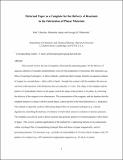| dc.contributor.author | Bracher, Paul J. | |
| dc.contributor.author | Gupta, Malancha | |
| dc.contributor.author | Whitesides, George M. | |
| dc.date.accessioned | 2012-11-06T19:13:44Z | |
| dc.date.issued | 2010 | |
| dc.identifier.citation | Bracher, Paul J., Malancha Gupta, and George M. Whitesides. 2010. Patterned paper as a template for the delivery of reactants in the fabrication of planar materials. Soft Matter 6(18): 4303-4309. | en_US |
| dc.identifier.issn | 1744-863X | en_US |
| dc.identifier.issn | 1477-6848 | en_US |
| dc.identifier.uri | http://nrs.harvard.edu/urn-3:HUL.InstRepos:9872257 | |
| dc.description.abstract | This account reviews the use of templates, fabricated by patterning paper, for the delivery of aqueous solutions of reactants (predominantly, ions) in the preparation of structured, thin materials (e.g., films of ionotropic hydrogels). In these methods, a patterned sheet of paper transfers an aqueous solution of reagent to a second phase—either solid or liquid—brought into contact with the template; this process can form solid structures with thicknesses that are typically ≤1.5 mm. The shape of the template and the pattern of a hydrophobic barrier on the paper control the shape of the product, in its plane, by restricting the delivery of the reagent in two dimensions. The concentration of the reagents, and the duration that the template remains in contact with the second phase, control growth in the third dimension (i.e., thickness). The method is especially useful in fabricating shaped films of ionotropic hydrogels (e.g., calcium alginate ) by controlling the delivery of solutions of multivalent cations to solutions of anionic polymers. The templates can also be used to direct reactions that generate patterns of solid precipitates within sheets of paper. This review examines applications of the method for: (i) patterning bacteria in two dimensions within a hydrogel film, (ii) manipulating hydrogel films and sheets of paper magnetically, and (iii) generating dynamic 3-D structures (e.g., a cylinder of rising bubbles of O\(_2\)) from sheets of paper with 2-D patterns of a catalyst (e.g., Pd\(^0\)) immersed in appropriate reagents (e.g., 1% H\(_2\)O\(_2\) in water). | en_US |
| dc.description.sponsorship | Chemistry and Chemical Biology | en_US |
| dc.language.iso | en_US | en_US |
| dc.publisher | Royal Society of Chemistry | en_US |
| dc.relation.isversionof | doi:10.1039/c0sm00031k | en_US |
| dc.relation.hasversion | http://gmwgroup.harvard.edu/pubs/pdf/1096.pdf | en_US |
| dc.relation.hasversion | http://gmwgroup.unix.fas.harvard.edu/pubs/pdf/1096.pdf | en_US |
| dash.license | OAP | |
| dc.subject | alginate hydrogels | en_US |
| dc.subject | release | en_US |
| dc.subject | films | en_US |
| dc.subject | microfluidics | en_US |
| dc.subject | biomaterials | en_US |
| dc.subject | systems | en_US |
| dc.subject | stamps | en_US |
| dc.subject | ions | en_US |
| dc.subject | gel | en_US |
| dc.subject | wax | en_US |
| dc.title | Patterned Paper as a Template for the Delivery of Reactants in the Fabrication of Planar Materials | en_US |
| dc.type | Journal Article | en_US |
| dc.description.version | Accepted Manuscript | en_US |
| dc.relation.journal | Soft Matter | en_US |
| dash.depositing.author | Whitesides, George M. | |
| dc.date.available | 2012-11-06T19:13:44Z | |
| dc.identifier.doi | 10.1039/c0sm00031k | * |
| dash.contributor.affiliated | Whitesides, George | |
| dc.identifier.orcid | 0000-0001-9451-2442 | |


